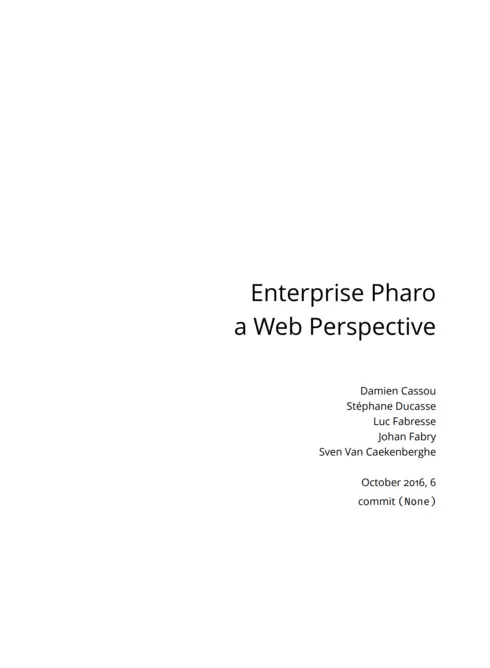
Enterprise Pharo a Web Perspective
No ratings
Copyright Year:
ISBN 13: 9781326650971
Publisher: Square Bracket Associates
Language: English
Formats Available
Conditions of Use
![]() Attribution-ShareAlike
Attribution-ShareAlike
CC BY-SA
Table of Contents
I Simple Web applications
- 1 Teapot
- 2 Building and Deploying a Small Web application
II HTTP
- 3 Character Encoding and Resource Meta Description
- 4 Zinc HTTP: The Client Side
- 5 Zinc HTTP: The Server Side
- 6 WebSockets
III Data
- 7 NeoCSV
- 8 NeoJSON
- 9 STON: a Smalltalk Object Notation
- 10 Serializing Complex Objects with Fuel
- 11 Persisting Objects with Voyage
IV Presentation
- 12 Mustache Templates for Pharo
- 13 Cascading Style Sheets with RenoirSt
- 14 Documenting and Presenting with Pillar
- 15 Generate PDF Documents with Artefact
V Deployment
- 16 Deploying a Pharo Web Application in Production
About the Book
Enterprise Pharo is the third volume of the series, following Pharo by Example and Deep into Pharo. It covers enterprise libraries and frameworks, and in particular those useful for doing web development. The book is structured in five parts.
The first part talks about simple web applications, starting with a minimal web application in chapter 1 on Teapot and then a tutorial on building a more complete web application in chapter 2. Part two deals with HTTP support in Pharo, talking about character encoding in chapter 3, about using Pharo as an HTTP Client (chapter 4) and server (chapter 5), and about using WebSockets (chapter 6).In the third part we discuss the handling of data for the application. Firstly we treat data that is in the form of comma-separated values (CSV) in chapter 7. Secondly and thirdly, we treat JSON (chapter 8) and its Smalltalk counterpart STON (chapter 9). Fourthly, serialization and deserialization of object graphs with Fuel is treated in chapter 10. Lastly, we discuss the Voyage persistence framework and persisting to MongoDB databases in chapter 11. Part four deals with the presentation layer. Chapter 12 shows how to use Mustache templates in Pharo, and chapter 13 talks about programmatic generationof CSS files. The documentation of applications could be written in Pillar, which is presented in chapter 14. How to generate PDF files from the application with Artefact is shown in chapter 15. The fifth part deals with deploying the web application. This is explained in chapter 16 that talks not only about how to build and run the application, but also other important topics like monitoring.
